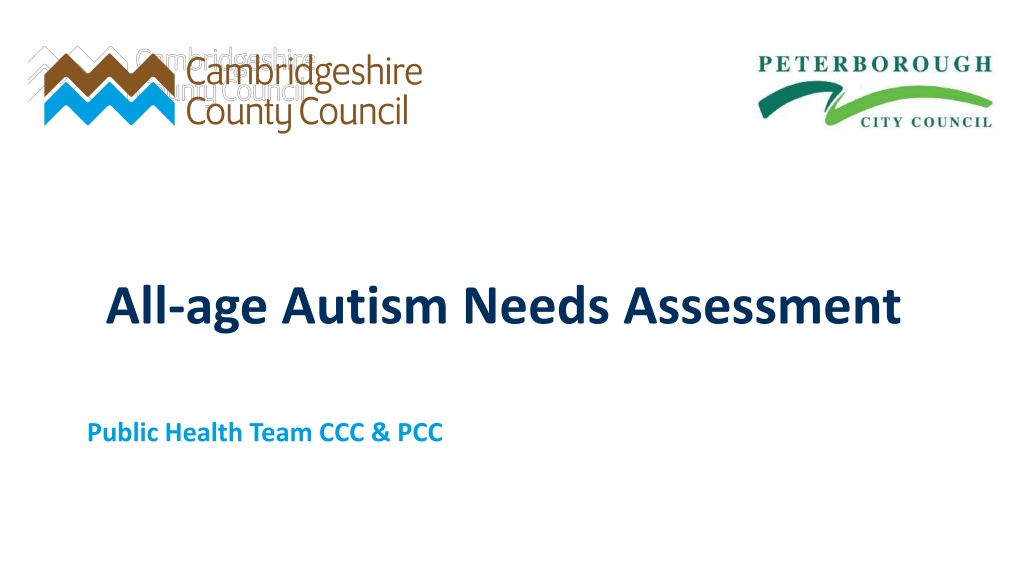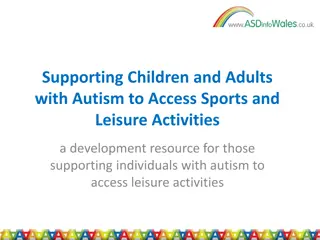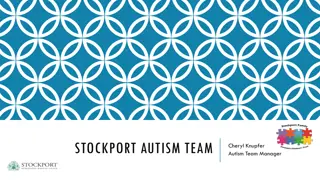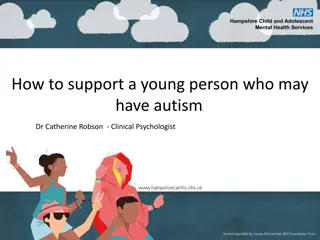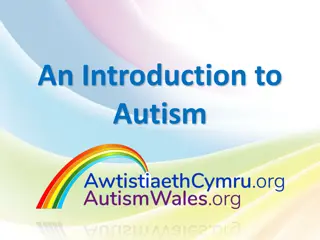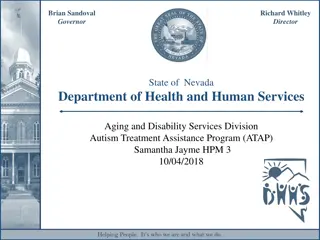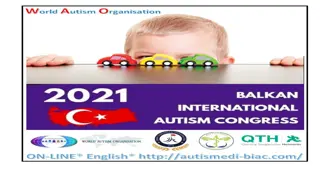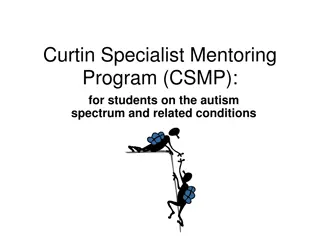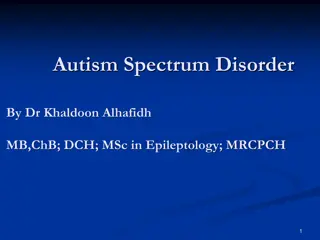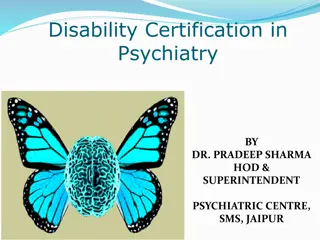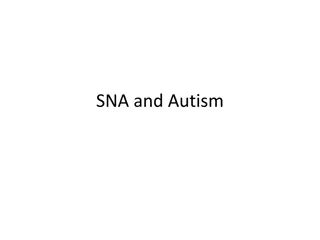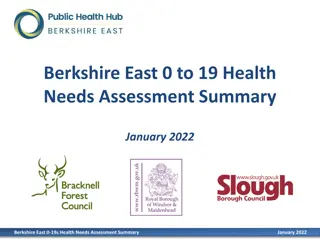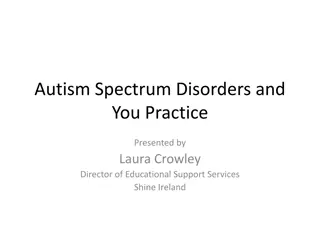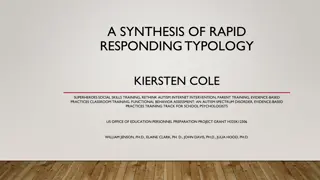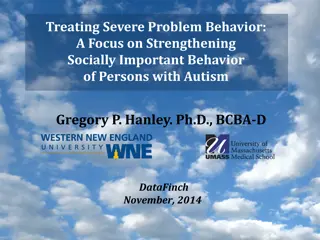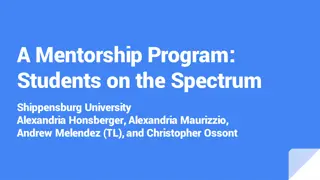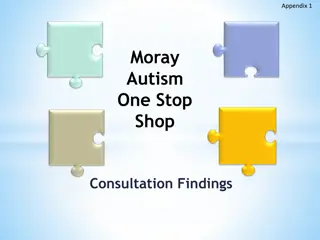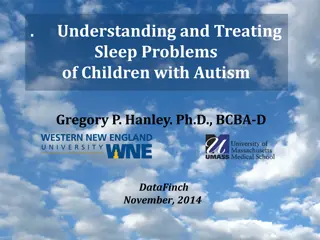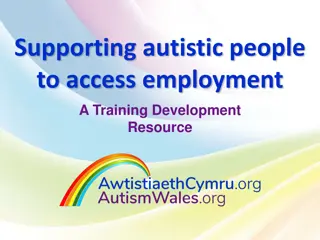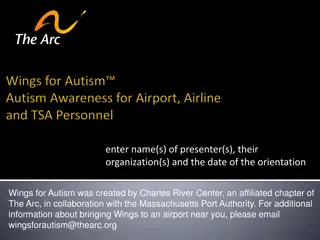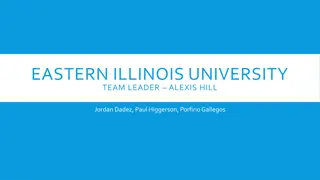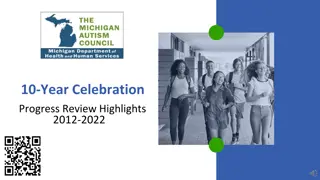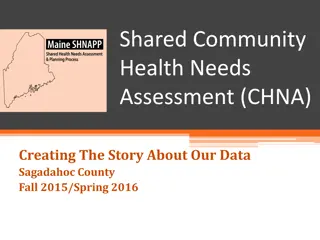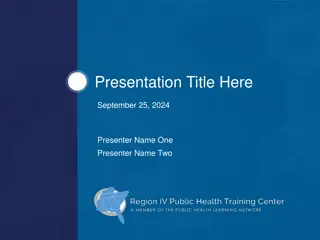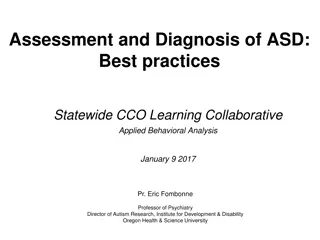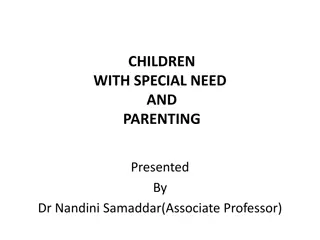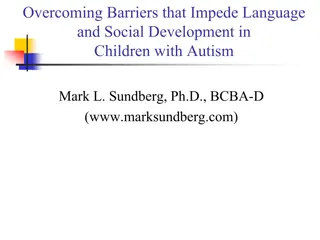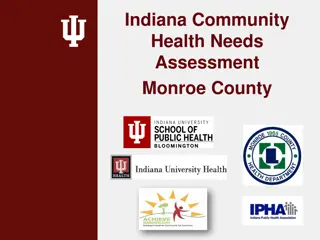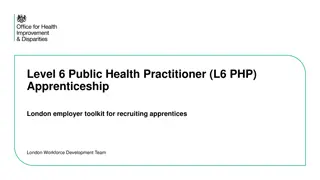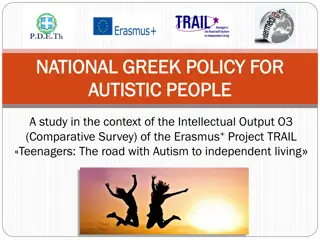Comprehensive All-Age Autism Needs Assessment by Public Health Team
This comprehensive assessment addresses the needs of individuals across all age groups with Autism Spectrum Disorder (ASD). It covers key findings, national and local policy contexts, epidemiological analysis, and recommendations for improving support and services. The report emphasizes the importance of early intervention, tailored care plans, and understanding ASD as a spectrum disorder with varying impacts over individuals' lifetimes.
Download Presentation

Please find below an Image/Link to download the presentation.
The content on the website is provided AS IS for your information and personal use only. It may not be sold, licensed, or shared on other websites without obtaining consent from the author. Download presentation by click this link. If you encounter any issues during the download, it is possible that the publisher has removed the file from their server.
E N D
Presentation Transcript
All-age Autism Needs Assessment Public Health Team CCC & PCC
Contents Abbreviations Definitions Acknowledgements 1. Executive Summary Introduction Aims Scope Key findings Recommendations 2. Introduction Contextual background Aims Autism Risk Factors Co-morbidities Barriers to accessing support 3. National Context NICE guidance on supporting people with autism National policy context 4. Local Policy Context
Contents cont. 5. Methods 6. Epidemiological Needs Assessment Prevalence ASC in school-aged children ASC in Adults Health, social and inequalities in people with ASC 7. Corporative Needs Assessment Mapping our services: assets and gaps Insider perspectives 8. Comparative Needs Assessment Learning from other areas 9. Next steps & recommendations
Abbreviations ASC CAMHS CCC CCG CiN CJS GP EHA EHCP HNA ICD JSNA LA NICE NHS PANSI PCC PHOF POPPI QOF SLC UK Autistic Spectrum Conditions Child and Adolescent Mental Health Services Cambridgeshire County Council Clinical Commissioning Group Child in Need Criminal Justice System General Practitioner Early Help Assessment Educational Health and Care Plan Health Needs Assessments International Classification of Diseases Joint Strategic Needs Assessment Local Authority National Institute of Clinical Excellence National Health Service Projecting Adult Needs and Services Information Peterborough City Council Public Health Outcomes Frames Projecting Older People Population Information Quality and Outcomes Framework Speech, Language and Communication United Kingdom
Definitions Autistic Spectrum Disorder (ASD) Defined by ICD-11; persistent deficits in the ability to initiate and to sustain reciprocal social interaction and social communication, and by a range of restricted, repetitive and inflexible patterns of behaviour and interests. The onset of the disorder occurs during the developmental period, typically in early childhood, but symptoms may not become fully manifested until later, when social demands exceed limited capacities. Deficits are sufficiently severe to cause impairment in personal, family, social, educational, occupational or other important area of functioning and are usually a pervasive features of the individuals functioning observable in all settings, although they may vary according to social, educational, or other context. Individuals along the spectrum exhibit a full range of intellectual functioning and language abilities used in some publications as an alternative to ASD as it can be considered the more appropriate wording to reflect the life course experiences of persons with autism. It recognises that although they will have autism throughout their life, it will only impact them at certain times and in differing ways, thus eliminating any perceived stigmatism and promotes their individual strengths A the legal document outlining a child or young person s special educational, health and social care needs and what additional help and support is required in order to meet those needs having intellectual abilities that result in a person experiencing difficulties with everyday activities. Whilst some people with autism have a learning disability, ASC itself is not considered a learning disability. learning difficulties (sometimes referred to as specific learning difficulties [SLD]) affect the way information is learnt and processed examples include dyslexia, dyscalculia, dyspraxia and attention hyperactivity deficit disorder (ADHD). Learning difficulties can occur alongside autism The Children s and Families Act (2014) defines SEN as a learning disability or difficulty which calls for special education provision to be made Autistic Spectrum Conditions (ASC) Education, Health and Care Plans (EHCP) Learning Disability Learning Difficulty Special Educational Needs (SEN) ASC is used throughout this needs assessment
Introduction: ASC Developmental condition characterised through differences in social interactions, perceptions, behaviours, communication and imagination Affects the way in which a person with ASC understands, functions in and interacts with the environment in which they inhabit Prevalence is thought to be ~1% of the population Not considered to be a mental health condition or learning disability, but many people with ASC also have one/or both of these conditions
Aims Understand the characteristics and health needs of people of all ages living with ASC in Cambridgeshire and Peterborough Use local and national sources to estimate the numbers of people with ASC and how these numbers are predicted to change with time Identify the service assets and gaps currently provided including the perspective and insights from service users and their carers Identify good practice in other areas of the UK Use the information to identify recommendations and to help inform an All Age Autism Strategy for Cambridgeshire and Peterborough
Scope 1. Estimated prevalence rates of the number of people in Cambridgeshire and Peterborough living with autism, including: - Those living with co-morbidities - Trends over time 2. Descriptions of the health and educational needs of people with autism in Cambridgeshire and Peterborough by age: -Early Years, Childhood and Adolescent (5-24 years) - Adulthood (25 years +) 3. Mapping of existing services and identification of any potential gaps or opportunities for improvement and stakeholder engagement. 5.Comparison with other regions and identification of best practices . 6. Recommendations for CCC and PCC to inform a strategy intent to improve outcomes for people living with autism.
Key Findings Estimated 5966 adults (25+) with ASC across Cambridgeshire and Peterborough in 2020 which is expected to increase overtime in line with increases in population size (6501 by 2035). Percentage of cases in the over 65s is set to increase from 25% to 32% by 2035 in line with population changes. Estimated 1840 school-aged CYPs (aged 5-17) and 2740 CYPs (aged 5-25) in 2020. These numbers are predicted to decrease slightly in the 5-17 category to 1740 but increase overall in the 5-25 category to 2780 by 2035. In 2019, 1912 children were known to have ASC in state-funded schools (primary, secondary and special). This is slightly higher than the predicted. Peterborough has a higher rate and Cambridgeshire a lower rate of ASC in primary school aged children compared to the national average. The rate of ASC among secondary school aged children is similar across the region and similar to the national average.
Key Findings cont. ~14% of CYPs (5-18 years) with ASC also have a form of disability and this is slightly higher in Cambridgeshire (~15%) compared to Peterborough (~10%). ~30% (776) of all community paediatric referrals are for ASC assessments (from CCS). Number of assessments for ASC varies from ~40-80 a month at CCS. CPFT equivalent data not available. 13 CYPs are on the transforming care register (at risk of hospital admission), the majority of girls on the register have an eating disorder and are currently T4 residents and the majority of boys on the register have a challenging behaviour and live at home. All CYPs on the transforming care register have ASC. There are no CYPs on the transforming care register with LD only and no ASC. For the last 3 years, the number of referrals for diagnostic assessment for ASC in adults has been 3-4 x higher than CPFT is commissioned to perform. Limited post-diagnostic or specialist services commissioned for adults with ASC. Particularly for adults with ASC but without learning disabilities.
Recommendations 1. All-age Autism Strategy Board: Establishment of a multi-agency All-age Autism Board for Cambridgeshire & Peterborough to provide strategic oversight and co-ordination with clear governance structures and links to operational groups which would report to the Board. One of the responsibilities of the All-Age Autism Board should be to develop an All-Age Autism Strategy for Cambridgeshire and Peterborough which should be co- produced with people with ASC and/or their family members/carers. 2. Joint commissioning: of seamless and integrated services and improvement on how to navigate through the system for all ages. 3. Early intervention: needs-led holistic support for children and families as well as building relationships and resilience in families and increasing capacity in assessment and post-assessment support courses. Commissioningofservicesfor CYPs requiring behavioural support and social skills/relationship training for adolescents and young adults with ASC. 4. Diagnosis: Ensuring that education and healthcare workers are aware of the typical signs of ASC in females to ensure appropriate identification and referral. 5. Workforce: Increased workforcecapacity and increased provision of training and awareness of ASC across the wider workforce as outlined in the Autism Act. ASC training of staff in Education settings is well established across CCC and PCC but more ASC awareness and training is needed among employers and services. 6. Employment: Increased employment opportunities for people with ASC.
ASC definition & prevalence ICD 2019: "Autism spectrum condition is characterized by persistent deficits in the ability to initiate and to sustain reciprocal social interaction and social communication, and by a range of restricted, repetitive, and inflexible patterns of behaviour and interests. The onset of the disorder occurs during the developmental period, typically in early childhood, but symptoms may not become fully manifest until later, when social demands exceed limited capacities. Deficits are sufficiently severe to cause impairment in personal, family, social, educational, occupational or other important areas of functioning and are usually a pervasive feature of the individual s functioning observable in all settings, although they may vary according to social, educational, or other context. Individuals along the spectrum exhibit a full range of intellectual functioning and language abilities." 1 % prevalence: increased in recent years, likely to be due to improved diagnostics. More common in males (maybe due to under-diagnosis in females. See page 73.) Source: Research Autism. ICD-11 Autism (Autistic Spectrum Disorder). Available at; http://www.researchautism.net/conditions/7/autism-(autism-spectrum-disorder)/Diagnosis
Risk Factors Genetic and environmental risk factors but none are necessary or sufficient for ASC: Older parental age at conception Exposure to chemicals/pollutants during fetal development Maternal nutritional status during pregnancy (under/over nutrition, and vitamin deficiencies Prenatal exposure to certain drugs/medication No evidence of an association between MMR (mumps, measles, rubella) vaccine with autism. Source: Gialloretti, E.L. Et al. (2019). Risk and Protective Factors Associated with Autism Spectrum Disorder: Evidence Based Principles and Recommendations. Journal of Clinical Medicine. Vol.8. Pp.217-240; Lai, MC. Lombardo, MV. & Baron-Cohen, S. (2014). Autism. The Lancet. Vol.383. Pp.896-910
Co-morbidities 70% of primary ASC diagnoses have a co-morbidity Condition Estimated proportion of people with ASC affected Developmental Learning disability Attention Hyper Deficit Disorder (ADHD) Tic disorders (including Tourette s Syndrome) 14-38% Motor abnormality General Medical Epilepsy Gastrointestinal Immune Dysregulation Genetic Syndromes Sleep Disorders 45% 28-44% 79% 8-30% 9-70% 38% 5% 50-80% Source: Lai, MC. Lombardo, MV. & Baron-Cohen, S. (2014). Autism. The Lancet. Vol.383. Pp.896-910
Co-morbidities cont. Condition Estimated proportion of people with ASC affected Personality Disorders Anxiety Depression Obsessive-compulsive disorders Psychotic disorders Oppositional Defiance disorder 42-56% 12-70% 7-24% 12-17% 16-28% Eating disorders Avoidant Personality Disorder Behavioural Aggressive behaviours Self-harm Suicidal ideation/intent or attempt Substance misuse 4-5% 13-25% 68% 50% 11-14% 16% Source: Lai, MC. Lombardo, MV. & Baron-Cohen, S. (2014). Autism. The Lancet. Vol.383. Pp.896-910
Barriers to Support Spectrum: therefore needs vary greatly, also the presence of co-morbidities requires appropriate tailored support 2011 study of ASC in the community found a majority of adults with ASC without a formal diagnosis People with ASC may face difficulty accessing universal services mitigated by wide-spread workforce training on ASC awareness Source: Brugha, TS. Et al. (2011). Epidemiology of Autism Spectrum Disorders in Adults in the Community in England. Journal Archive of General Psychiatry. Vol.68, No.5, Pp.459-465. Social Care, Local Government and Care Partnership Directorate. (2014). Think Autism: Fulfilling and rewarding lives, the strategy for adults with autism in England an update. Available at; https://assets.publishing.service.gov.uk/government/uploads/system/uploads/attachment_data/file/299866/Autism_Strategy.pdf
Aims Understand the characteristics and health needs of people of all ages living with ASC in Cambridgeshire and Peterborough Use local and national sources to estimate the numbers of people with ASC and how these numbers are predicted to change with time Identify the service assets and gaps currently provided including the perspective and insights from service users and their carers Identify good practice in other areas of the UK Use the information to identify recommendations and to help inform an All Age Autism Strategy for Cambridgeshire and Peterborough
NICE Guidance ASC in <19 year olds ASC in adults Identification, assessment, diagnosis Identification Referral Assessment Management Diagnosis Management Transition to adult services
NICE Guidance NICE guidance on ASC in adults: diagnosis and management (2016) NICE guidance on ASC in under 19s: support and management (2013) Key principles for working with people with ASC and their families: Working in partnership Offering support and care Building relationships Training of staff on ASC awareness Multi-agency local autism strategy group, with representation from people with ASC.
National Policy Context Autism Act 2009: National government to develop a nation autism strategy for Adults in England Fulfilling and Rewarding Lives published in 2010 and Think Autism in 2014: Local authorities and health trusts to implement the National Strategy
National Policy Context Fulfilling and Rewarding Lives : ASC awareness training for staff in public, heath and social care services Setting up local diagnostic pathway based on NICE guidance and increasing diagnostic capacity Ensuring adults with ASC and their carers have access to local support and services enabling them to live independently within their community Person-centred assessment and personalised care and support for those diagnosed with ASC Supporting CYPs with ASC transitioning in adult services Supporting adults with ASC into meaningful employment and having a choice and control about where they live Involve adults with ASC and their carers in the development of local services
National Policy Context Think Autism : Autism Aware communities: establishing autism awareness projects within local communities Funding local projects that promote innovative services and preventative support Raising awareness across public services through ASC awareness training programmes Improving data collection and sharing between relevant services Local authorities required to improve services for adults with autism and to implement the National Autism Strategy (possibly through setting up an Autism Partnership Board .
Local Policy Context Cambridgeshire and Peterborough aim to help people to live independent lives in the community; to protect the most vulnerable in society and to provide support to people when they need it most. Currently there are three strategies for ASC across Cambridgeshire and Peterborough. Cambridgeshire has one strategy for CYPS (2016) and one for adults and Peterborough had one strategy for all ages (2018, still in draft) and there are three ASC strategy boards. The degree of co-production of these strategies has been inconsistent. While training is available to improve ASC awareness among health and social care staff, these courses only occur a few times a year.
Type of Needs Assessment Epidemiological: Department of Education (2018-2019) CCG/service data (Liquid Logic) National prevalence estimates applied to local data (Poppi and Pansi) Corporate: Engagement with service users and their families/carers Mapping of services and identifying gaps Comparative: Comparison with services offered in other areas Identifying best practices
Data Source Purpose Literature Review Risk factors, guidance, best practice Poppi/Pansi ASC prevalence predictions Department for Education** ASC in school-aged children Population estimates ONS Fingertips Local ASC prevalence compared with other areas Liquid Logic ASC and children with disabilities CCG Adult referrals and diagnoses CCS ASC community paediatric referrals PinPoint & Family Voice Service user feedback **Limitations: only information from state funded schools
6.Epidemiological Needs Assessment
CYP Prevalence estimates 2019 NB: prevalence estimates of ASC in 0-4 year olds is unavailable as ASC assessments tend to occur from the age of 5+ 1 1 120-24 year olds 2.2% 0.7% 1.5% 2 Prevalence Boys Girls Total 5-10 year olds 2.5% 0.4% 1.5% 11-16 year olds 1.8% 0.7% 1.2% 17-19 year olds 1.0% 0.0% 0.5% Local Authority Estimated number of children and young people Total 5-10 year olds 130 110 100 190 190 720 280 1000 11-17 year olds 100 90 90 160 160 600 200 800 18-24 year olds 320 70 90 140 110 730 170 900 Cambridge East Cambridgeshire Fenland Huntingdonshire South Cambridgeshire Cambridgeshire Peterborough Total 550 260 280 490 460 2,040 660 2700 Source: 1Mental Health of Children and Young People in England, 2017 and mid 2019 population estimates, Office for National Statistics and 2Adults Psychiatric Morbidity Survey, 2014, NHS Digital
CYP Prevalence cont. Cambridgeshire 2019 2020 2025 2030 2035 5-10 years 11-17 years 18-24 years Total 720 600 730 2,040 2,060 2,080 2,100 2,070 720 620 720 680 680 710 640 660 800 620 620 830 Peterborough 2019 2020 2025 2030 2035 5-10 years 11-17 years 18-24 years Total 280 200 170 660 290 210 170 680 280 260 170 710 260 260 200 720 260 240 220 710 Totals Cambridgeshire & Peterborough 5-17 years Cambridgeshire & Peterborough 5-24 years 2019 1800 2,700 2020 1840 2,740 2025 1900 2,790 2030 1820 2,820 2035 1740 2,780 Source: Mental Health of Children and Young People in England, 2017 and mid 2019 population estimates, Office for National Statistics and Adults Psychiatric Morbidity Survey, 2014, NHS Digital
Adult Prevalence Cambridgeshire 2019 2020 2025 2030 2035 25-34 years 35-44 years 45-54 years 55-64 years 65-74 years 75+ years Total population 25 years + 852 826 910 795 664 520 4567 850 825 900 815 664 542 4596 818 845 847 881 668 674 4733 778 851 832 869 787 749 4866 805 824 860 826 824 835 4974 Peterborough 2019 2020 2025 2030 2035 25-34 years 35-44 years 45-54 years 55-64 years 65-74 years 75+ years Total population 25 years + 314 291 260 211 161 120 1357 313 294 261 215 163 124 1370 294 312 263 237 170 153 1429 277 314 276 242 193 174 1476 286 299 293 240 211 198 1527 Cambridgeshire & Peterborough 25 year + 5924 5966 6162 6342 6501 Source: Pansi and Poppi
ASC in >65 year olds Percentage of predicted ASC cases to be aged 65+ from 2019-2035 2019 2020 2025 2030 2035 Cambridgeshire 26 % 26 % 28 % 32 % 33 % Peterborough 21 % 21 % 23 % 25 % 27 % Cambridgeshire and Peterborough 25 % 25 % 27 % 30 % 32 % Source: Pansi and Poppi
Primary School Aged children Number of children with ASC % of SEN with ASC Rate of ASC per 1000 pupils England 52,808 7.9% 11.2 Cambridgeshire 447 6.3% 8.6 Peterborough 316 11.1% 11.2
Secondary School Aged Children Number of children with ASC % of SEN with ASC Rate of ASC per 1000 pupils England 12.8 42,555 10.3 Cambridgeshire 13.4 440 11.5 Peterborough 13.3 213 12.8
Special School Children Number of children with ASC % of SEN with ASC Rate of ASC per 1000 pupils England 303.8 36,982 29.8 Cambridgeshire 232.8 284 23.3 Peterborough 318.3 212 31.9
All school aged children Number of school aged children with ASC* Rate of ASC per 1000 pupils* England 16.2 132,345 Cambridgeshire 13.6 1,171 Peterborough 19.6 741 Cambridgeshire & Peterborough School aged children with ASC 1912 Predicted number based on national prevalence 1800 *Includes state funded primary, secondary and special schools. Source: DfE, State funded schools. January 2019
CWD and ASC (5-18 years) Total ASC Total CWD Total CWD with ASC % of CWD with ASC % of ASC with CWD** Cambridgeshire 1,171 463 174 37.6% 14.8% Peterborough 741 295 76 25.8% 10.3% Cambridgeshire & Peterborough 1,912 758 250 32.9% 13.7% **Likely to be an underestimation. Source: CWD data is obtained from Liquid Logic CCC & PCC, Snap-shot 30/06/2020. 5-18 years of age
Annual Assessments for ASC in CYPs in Cambridgeshire (CCS) CCS has an 18 week pathway from accepting a referral to first appointment. Although not all referrals are accepted (prioritisation based on need and younger age) ~30% of ASC assessments are are in females Annual Assessments in Cambridgeshire 2019-2020 Annual assessments for ASC: 776 (29% of all community paediatric assessments)
Transforming Care Register Characteristics Description Males 57% challenging behaviour Females 66% eating disorder All CYPs on the transforming care register have ASC. There are no CYPs on the transforming care register with LD only and no ASC. Source: CCG- Transforming Care Register Jun 2020, CYPs ASC who are at risk of hospital admission to T4* (mental health inpatient setting)
Adult referral/diagnosis No. of diagnostic assessments 144 135 132 % People who get a diagnosis 87.50% 81% 79.50% Year No. of referrals 2016-2017 2017-2018 2018-2019 386 349 453 Substantial mismatch in supply and demand of number of diagnostic assessments commissioned Source: CCG 2020
Adult characteristics data: PCC 95 adults (18-64) with open cases on Mosaic database at PCC 79 % are white British 11 % are Asian or Asian British 4 % are Black or Black British 4 % mixed ethnicity 2 % unstated ethnicity 79 % for learning disability support 3 % for disability support 5 % for mental health support 2 % for physical support 5 % for social support 6 % for support unknown
Health, Social and Inequalities in people with ASC
Health inequalities and ASC People with ASC are more likely to experience health inequality compared with those without ASC1. Contributing factors include: lower attainment at schools greater unemployment, social exclusion and less access to housing. Studies have shown that life expectancy in ASC is lower than the general population (54 vs 70 years respectively)2 and are 7.5x more likely to die by suicide. Improving access to education, health and social care services may help to reduce the health inequalities. 1Shropshire Council. Shropshire Autism Needs Assessment for Children and Young People Aged 0-25. 2016. Available from: http://www.shropshiretogether.org.uk/wpcontent/uploads/2016/05/Final-Shropshire-Autism-Needs-Assessment-edited- Jan2016.pdf 2Hirvikoski T, Mittendorfer-Rutz E, Boman M, Larsson H, Lichtensten P, Bolte S. Premature mortality in autism spectrum disorder. The British Journal of Psychiatry. 2016;208(3):232-238.
